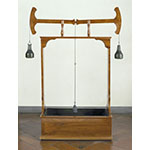This instrument is often called the Pascal apparatus, after Blaise Pascal, although the phenomenon known as the "hydrostatic paradox" was first analyzed by Simon Stevin. In De l'équilibre des liqueurs et de la masse de l'air (Paris, 1663), Pascal demonstrated with a similar instrument that the hydrostatic pressure acting on the bottom of a vessel is determined solely by the height of the column of liquid (and obviously by its specific weight)—not by its volume or the shape of the vessel.
This model is already described as largely incomplete in the 1776 inventory of the Lorraine collections. It is based on a version described by Jean-Antoine Nollet in Leçons de physique expérimentale (Paris, 1743-1748).
A wooden box containing a tin-plated tub carries a frame supporting two rocking levers pivoting on a pair of posts. Two containers for weights are suspended from cords to the outer ends of the levers. The inner ends each carry a weight hanging over the center of the instrument. Originally, however, the rocking levers were connected to the piston of a square vessel (now missing) placed in the tub. The vessel had a threaded opening for attaching glass tubes of different diameters and shapes but equal base diameter. The piston thus fit on the bottom of all the tubes. By filling the tubes with water, one could show that the pressure exerted on the piston depended exclusively on the height of the liquid column, irrespective of the vessel's shape. For example, the base of a rather large cone or of a fairly narrow tube (with, however, the same surface area at their base), filled with water, was kept sealed by an identical weight applied to the rocking levers, provided that the level of liquid in the vessels was the same. This phenomenon, which at first sight may seem surprising, was known as the "hydrostatic paradox."










